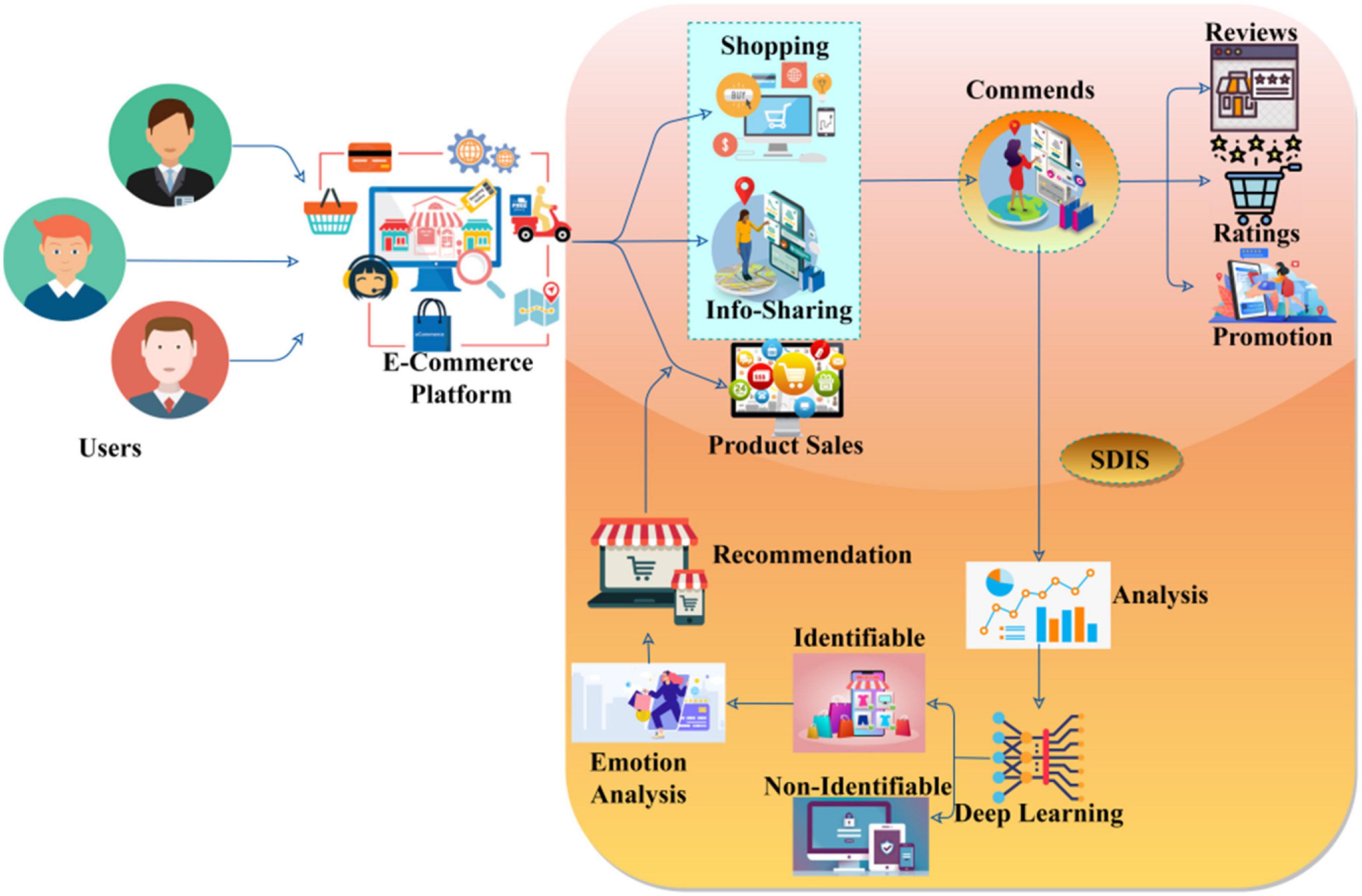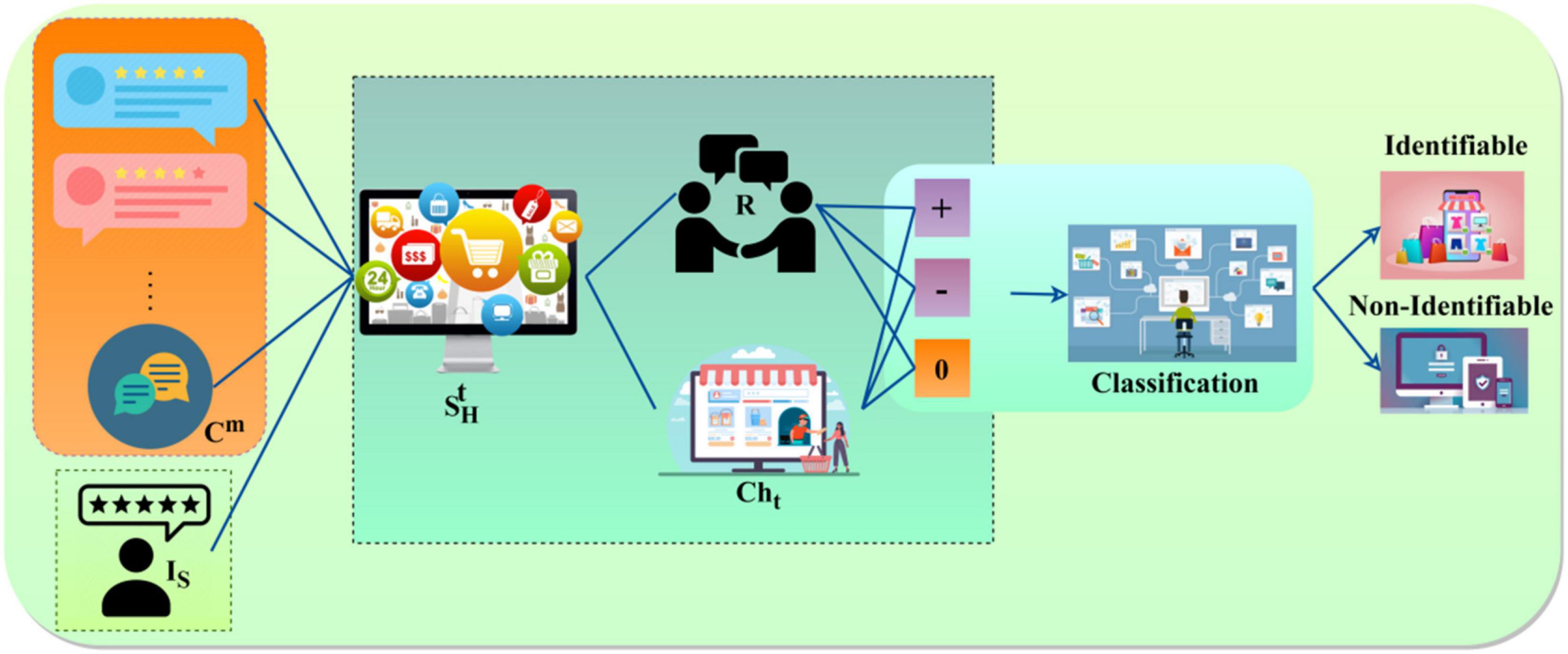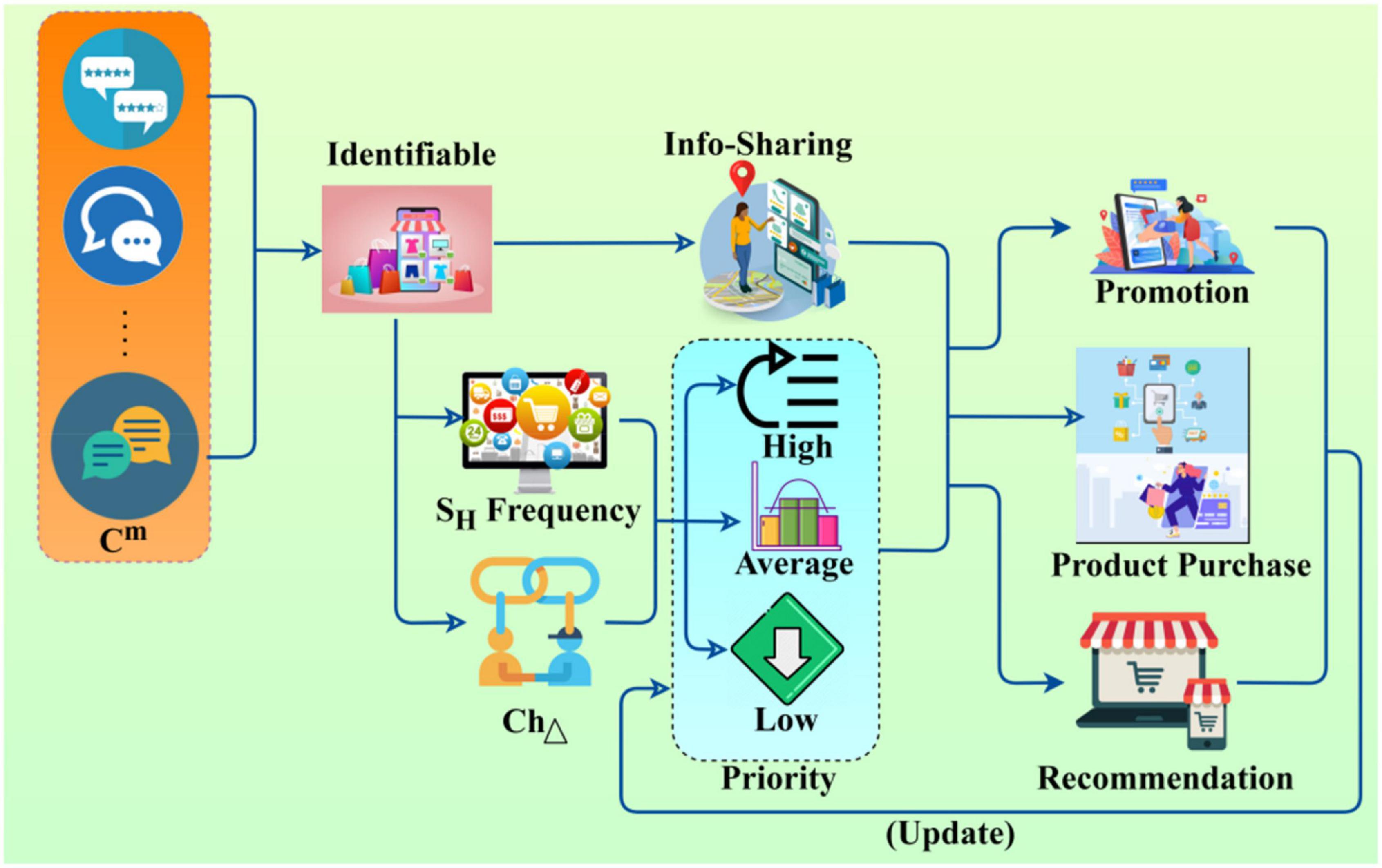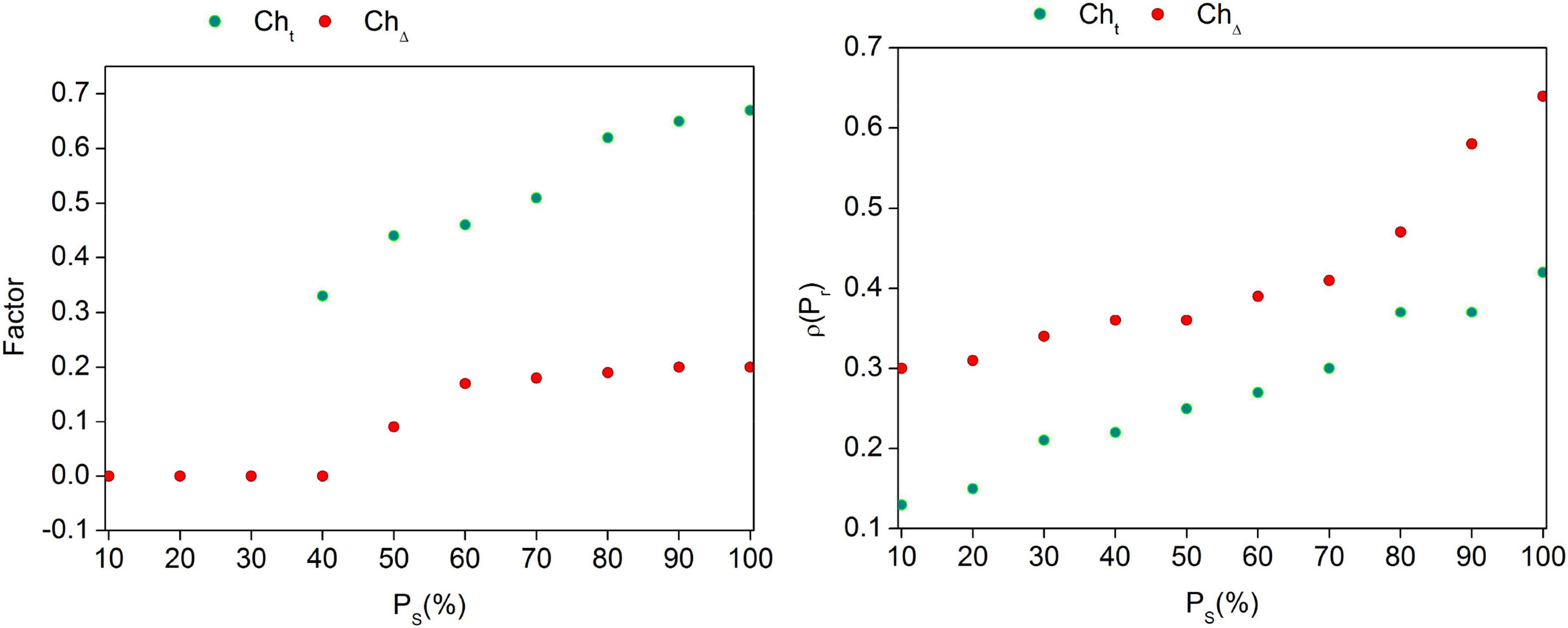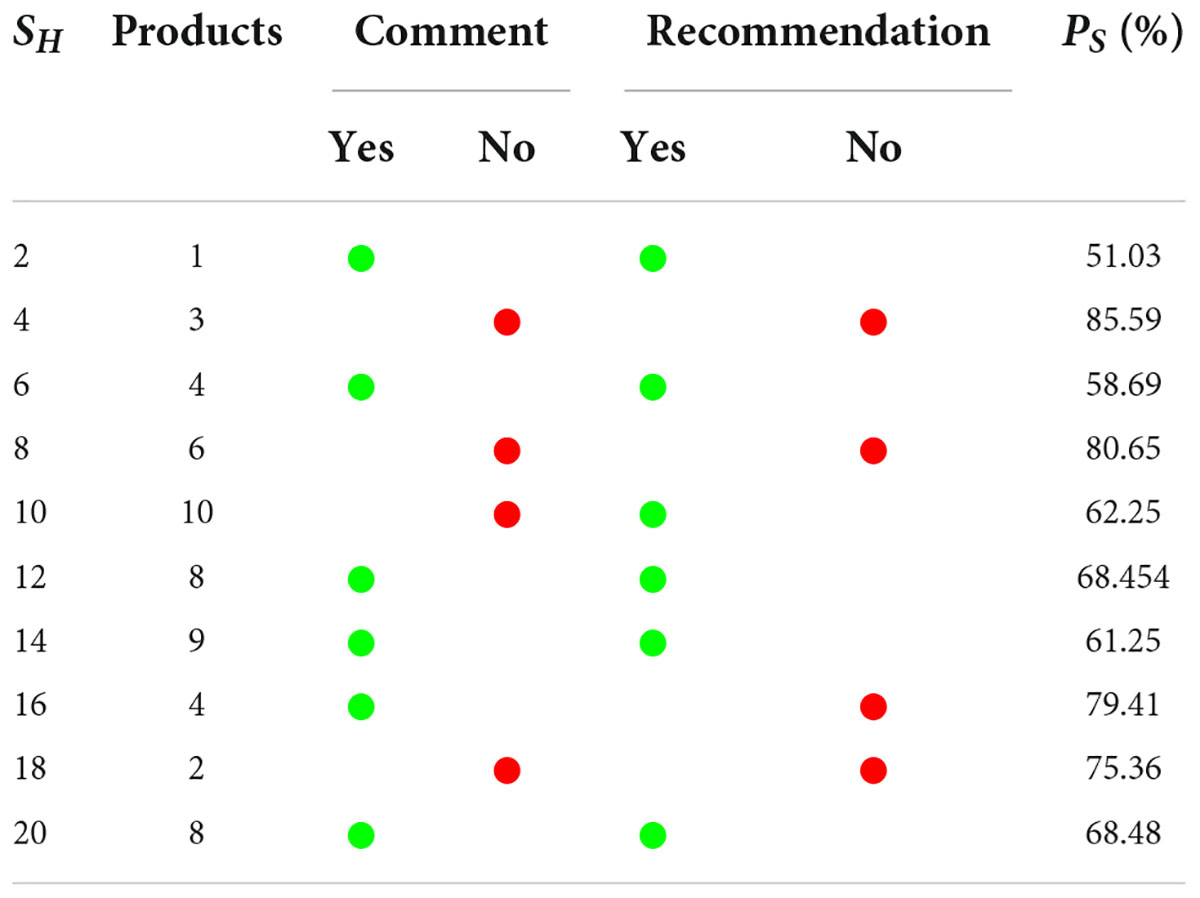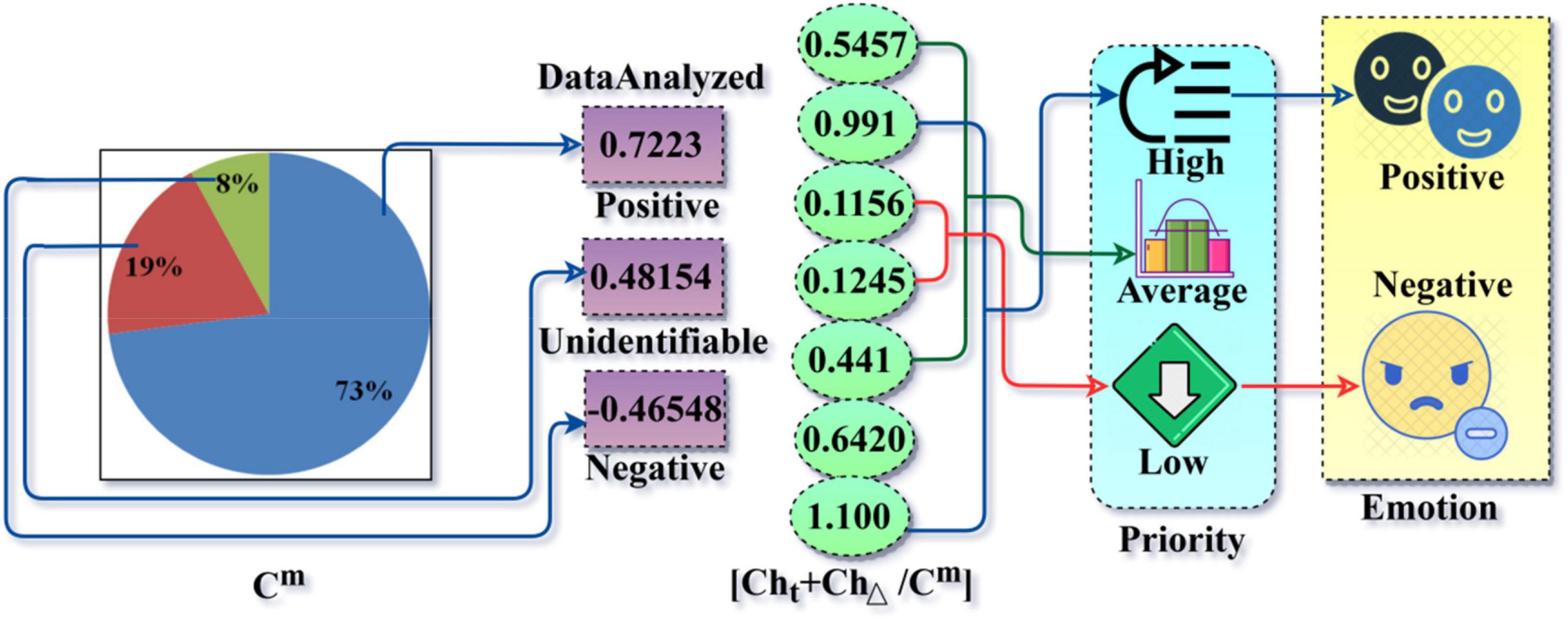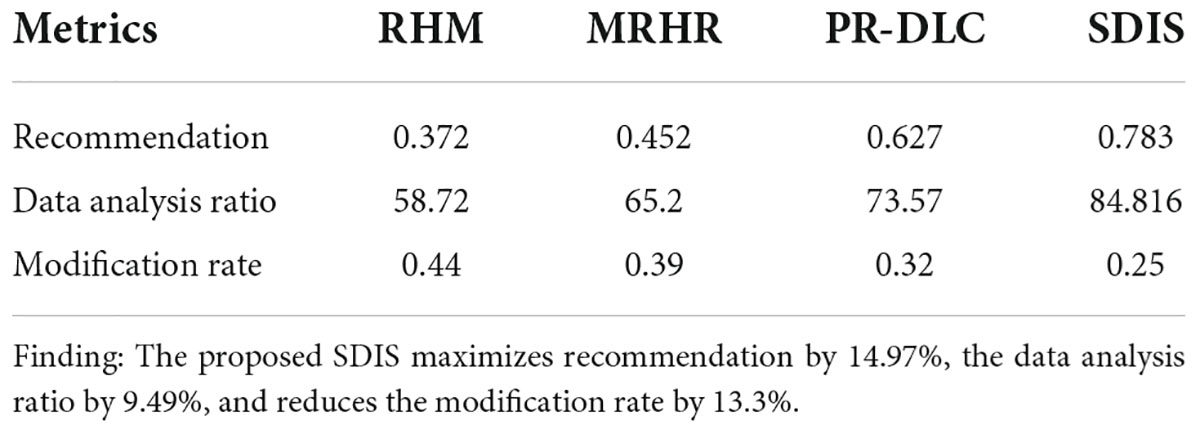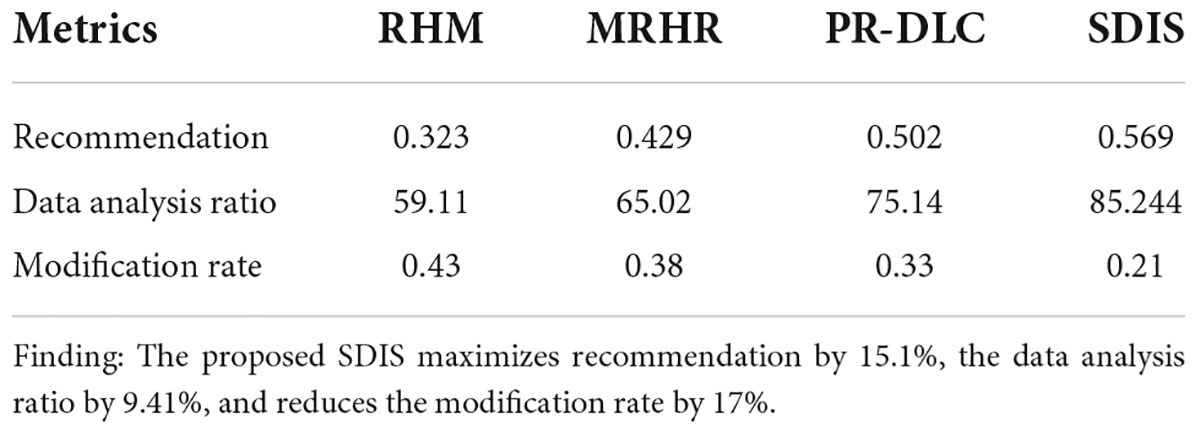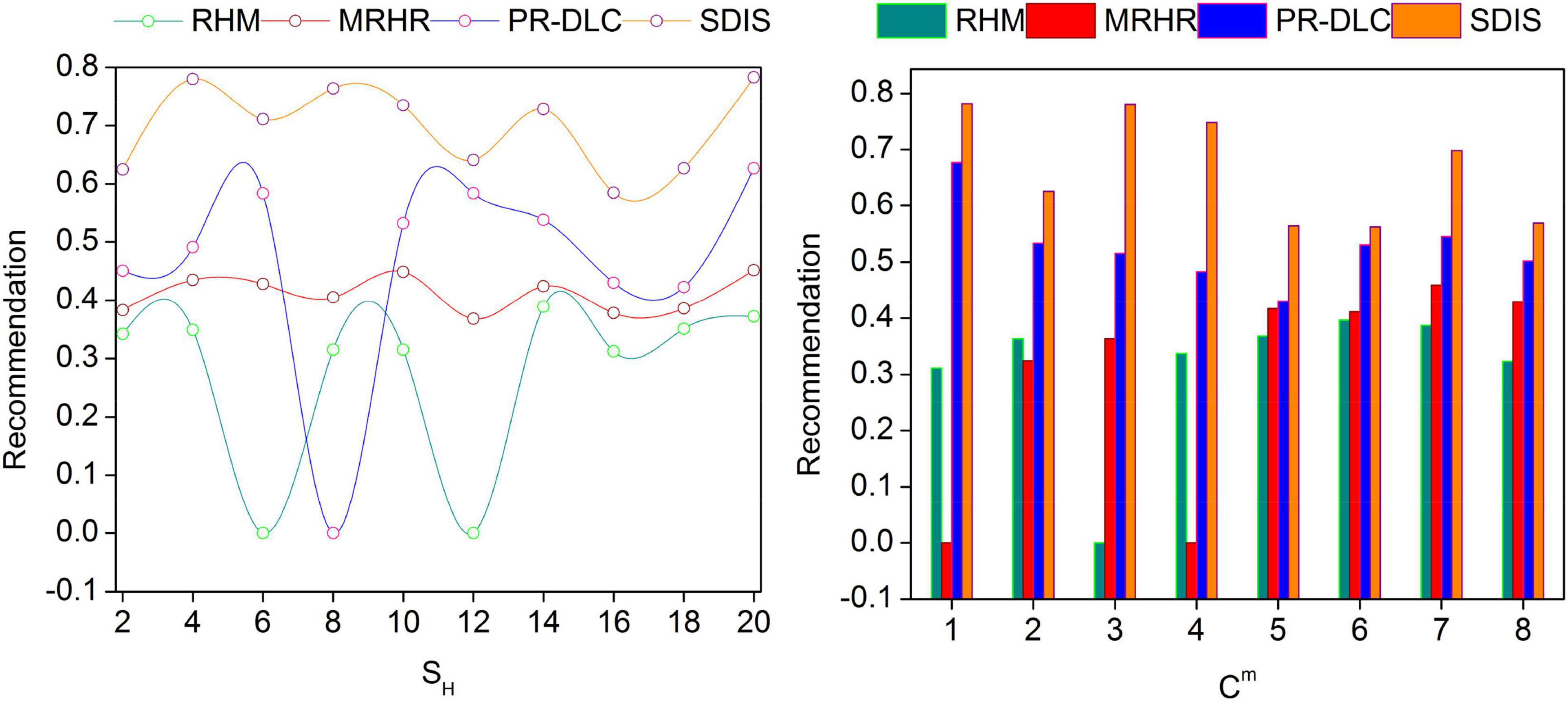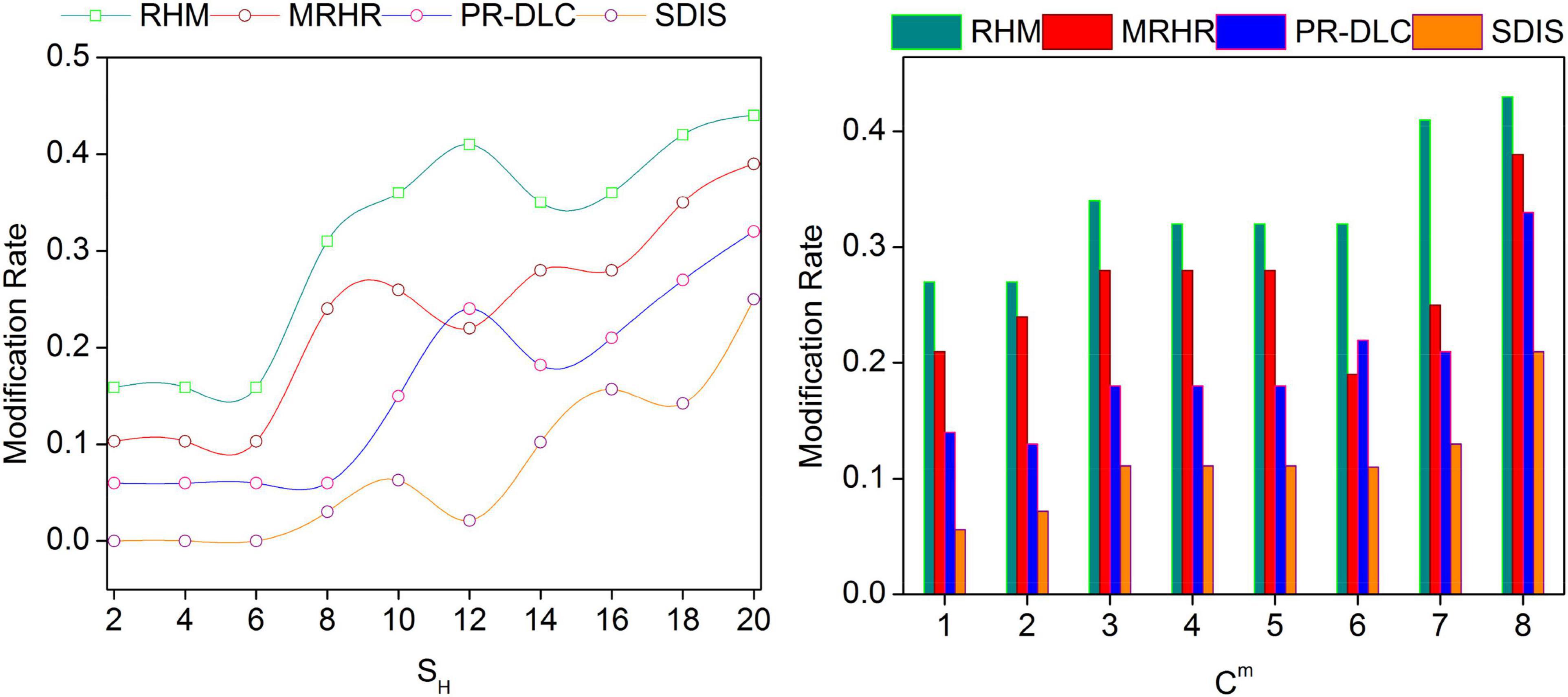- School of Joumalism and Communication, Sichuan International Studies University, Chongqing, China
Electronic commerce (E-commerce) through digital platforms relies on diverse user features to provide a better user experience. In particular, the user experience and connection between digital platforms are exploited through semantic emotions. This provides a personalized recommendation for different user categories across the E-commerce platforms. This manuscript introduces a Syntactic Data Inquiring Scheme (SDIS) to strengthen the semantic analysis. This scheme first identifies the emotional data based on user comments and repetition on the E-commerce platform. The identifiable and non-identifiable emotion data is classified using positive and repeated comments using the deep learning paradigm. This classification attunes the recommendation system for providing best-affordable user services through product selection, ease of access, promotions, etc. The proposed scheme strengthens the user relationship with the E-commerce platforms by improving the prioritization of user requirements. The user’s interest and recommendation factors are classified and trained for further promotions/recommendations in the learning process. The recommendation data classified from the learning process is used to train and improve the user-platform relationship. The proposed scheme’s performance is analyzed through appropriate experimental considerations. From the experimental analysis, as the session frequency increases, the proposed SDIS maximizes recommendation by 15.1%, the data analysis ratio by 9.41%, and reduces the modification rate by 17%.
Introduction
E-commerce platforms are places where an individual can buy and sell products or goods using an internet connection. E-commerce applications make use of software applications that are mainly designed to provide various services for supporting E-commerce among individuals and organizations (Nguyen and Cho, 2020). E-commerce is an emerging technology that increases the efficiency rate in communication services for users. The recommendation model is most commonly used in E-commerce to improve the quality of service (QoS) and the effectiveness of goods (Li et al., 2019). Optimization algorithms are used in the recommendation model, which finds out the details and knowledge of goods to provide an effective dataset for consumers in an online application (Liao et al., 2021). The recommendation model creates a taxonomy to identify the product’s location, details, and information for consumers. The recommendation model improves the efficiency and effectiveness of E-commerce applications that provide better performance and services for users (Coussement et al., 2021). A classification method-based recommendation model is also used in E-commerce, which identifies customers’ requirements by analyzing the previous activities of users. The knowledge discovery technique is used in the classification method to determine the personalities and characteristics of products and provide an optimal set of data for customers in E-commerce applications (Chen et al., 2021b).
Emotion analysis is a process that identifies and analyzes the emotions expressed in text format. The emotion analysis process extracts the exact meaning of data and understands the emotion given by the users (Chung and Zeng, 2020). The emotion analysis process plays a major role in various fields that determine the meaning of a text by performing an analysis process. Emotion analysis is most commonly used in the E-commerce recommendation model that provides an important set of data that provide better services for users (Grigorios et al., 2022). The emotion analysis process improves the quality and performance of services that E-commerce recommendation models provide. A multi-classification method is used in the emotion analysis process, identifying various emotions and providing exact details about each text and message (Meng et al., 2021). Emotions are classified based on previously recorded details and produce a final set of data for the communication and interaction process in E-commerce. The multi-classification method identifies emotions such as happiness, anger, disappointment, and misunderstanding. Multi-classification increases the accuracy rate and efficiency rate in the emotion analysis process, which indicates the actual meaning of text formats (Zhao et al., 2019; Kang et al., 2021).
Machine learning (ML) techniques are mostly used in the detection, prediction, and analysis processes, improving the overall accuracy rate in the prediction process. The ML technique is also used in the E-commerce emotion analysis process to identify the customers’ actual meaning of text and messages (Demircan et al., 2021). The convolutional neural network (CNN) algorithm is used in the emotion analysis process, which predicts and detects the exact emotions of users. The feature extraction process is used in CNN, which extracts customers’ exact emotions and feelings in an E-commerce application (Xu et al., 2020). CNN combines the current emotions with previously recorded emotions and finds out the exact meaning of the user’s emotions. A gated recurrent unit (GRU) is also used in the E-commerce emotion analysis process that extracts the important emotions and details from textual messages (Ghavamipoor and Hashemi Golpayegani, 2020). The attention mechanism is used in GRU to classify the weight of emotions and produce the text’s actual meaning, which enhances the efficiency rate of E-commerce applications. A support vector machine (SVM) algorithm is commonly used in the E-commerce emotion analysis process that predicts the emotion based on a certain set of features. SVM collects the necessary data from the database and provides exact sentiments and emotions of customers in E-commerce applications (Guo, 2020; Xu et al., 2022).
Related Works
Wang H. et al. (2020) introduced a domain recommender method using a deep neural network (DNN) approach for E-commerce. The main goal of the proposed method is to solve the cold-start problem presented in the online shopping application. DNN compared the domains and users to find out the problems and provide optimal solutions to cold-start problems. The proposed domain recommender method reduces the problems and provides various services for users in online shopping. The proposed method increases the effectiveness and efficiency of E-commerce.
Chen et al. (2021a) proposed a new storytelling recommendation method for E-commerce platforms using an additional domain transfer network. The proposed method is mainly used to identify the interests and searches of users and then produce an accurate set of data for a service provider. First, user behavior patterns are identified using an additional domain transfer network, and domain gaps are identified by the domain transfer network and produce effective details about each domain. The proposed method reduces the error rate in service providers and improves the feasibility of E-commerce.
Gao et al. (2020) introduced a triad-based word-of-mouth recommendation (TriM) model for socialized E-commerce applications. In E-commerce, the user sends product links to other persons and promotes the products. The proposed TriM model finds out both user and receiver details and produces an optimal dataset for the analysis process. The produced data are used to identify the interests of users in E-commerce. The TriM model improves the performance and efficiency of providing services for users in social E-commerce applications.
Ji et al. (2019) proposed a hybrid recommendation model for social E-commerce. Ratings, reviews, requests, interests, and searches are collected for the data analysis process. The recommendation model detects the actual interest of users based on previously recorded data and provides necessary services to the users. A regression algorithm is used here to identify users’ features and behavior patterns for the recommendation process. Experimental results show that the proposed method improves the effectiveness and performance of the E-commerce system.
Wang and Qiu (2021) proposed a new DNN model using side information for the fashion collaboration recommendation process in E-commerce. Purchase data, product details, textural description, and user interest are collected and analyzed using the DNN model. The fashion collaboration recommendation model identifies users’ experience with products and services provided by E-commerce. The proposed model improves the efficiency and feasibility of E-commerce by reducing the latency rate in product searching.
Islek and Oguducu (2022) introduced a hierarchical recommendation model using online user reviews for E-commerce platforms. Textural information of the products is identified by bidirectional encoders and produces an optimal set of data for a service provider. The hierarchical recommendation model provides a transparent system for the users, which improves the trustworthiness of the platforms. The proposed method increases the accuracy rate in the identification process, which improves the performance of the E-commerce system.
Wijaya (2022) proposed a conceptual model for E-commerce using a recommendation system. Product details and reviews are filtered, producing an actual dataset for the recommendation process. Hyper-personalization is used here to provide optimal recommendations for users in E-commerce. The proposed model increases conceptual products’ overall efficiency and effectiveness in online shopping platforms.
Wang K. et al. (2020) introduced a personalized recommendation analysis process for E-commerce using a deep-learned clustering approach. A deep learning clustering algorithm is used here to analyze the data needed for the recommendation process in online shopping. The clustering method identifies users’ patterns, interests, and behavior. Product information, location, and delivery time are recommended for users by the proposed analysis process. The proposed recommendation analysis method improves the effectiveness of E-commerce.
Zheng et al. (2021) proposed a recommendation model for E-commerce using heterogenous type-specific information. The user’s latent features and patterns are identified for the recommendation process. The proposed recommendation model provides necessary services and products for users with an effective set of details. Experimental results show that the proposed model increases the accuracy rate in the recommendation process and improves the system’s efficiency.
Mao et al. (2019) introduced a hypergraph ranking method for the recommendations process in E-commerce. The ranking method identifies users’ searches, interests, requests, and feedback. The proposed ranking method provides a feasible dataset for the recommendation process. Multi-objective recommendations and searches are collected and stored for further analysis process. The proposed model provides effective details and products for users through a recommendation process in the E-commerce system.
Xia et al. (2021) proposed an outlier data mining-based recommendation model for E-commerce. The proposed model is mainly used for the knowledge management process and provides an optimal dataset for the analysis process. A filtering algorithm is used to fetch the necessary data for the recommendation process. The data mining approach finds out the details of the recommendation process and provides data for the service provider. The proposed model improves the efficiency and effectiveness of E-commerce.
Li et al. (2022) introduced a new recommendation model using a hybrid recommendation algorithm for E-commerce. In an online shopping platform, image content information is collected, containing details about users’ reviews and requests. A classification method is used here to classify the details and produce the final dataset for the recommendation process. Image content and features are necessary for providing an effective dataset for the recommendation process. The proposed recommendation model reduces the latency rate in the search process and improves the accuracy rate in recommending goods to the users.
Zhou (2020) proposed a deep learning-based recommendation model for E-commerce. Deep learning is used here to predict users’ interests and searches, providing an effective recommendation process details. Users’ expressions over products and goods are also identified using certain filters. The identified data plays a vital role in the recommendation process that finds out the actual interest of users in online shopping platforms. The proposed model improves the accuracy rate in the recommendation process that reduces the complexity and latency rate in the analysis process.
Ding et al. (2019) introduced a user-centered recommendation-based dynamic graph model for E-commerce. A user clustering algorithm is used to identify the necessary dataset for the recommendation process. The clustering algorithm identifies preference and interest patterns and produces a feasible dataset for the dynamic graph model. Compared with other models, the propped graph model increases the accuracy rate in the recommendation process.
The Proposed Syntactic Data Inquiring Scheme
A Syntactic Data Inquiring Scheme (SDIS) is designed to improve the user relationship with the E-commerce platforms. The user-platform relationship analysis is based on diverse user feature inputs of digital platforms. The user experience and connection between E-commerce platforms are required from the semantic emotions and the personalized recommendation observed in different time instances through user shopping and information sharing based on the product sales in the E-commerce platform. The semantic emotional analysis is based on digital user comments and repetition on the E-commerce platforms. Figure 1 portrays the proposed SDIS.
The main role of this scheme is to reduce negative comments and repeated comments on decentralized E-commerce platforms. The risk factor in this work is a classification of identifiable and non-identifiable emotional data analysis recommendations for the new media era with the new user comments and user relationship instances. The users’ comments are stored in the form of reviews, ratings, and promotions from the previous user emotion data based on positive and repeated comments. The multi-resource access and information sharing require a recommendation system based on conventional user services for buying products on E-commerce platforms (refer to Figure 1). The shopping activities on digital platforms are accessed through user relationships, and they provide best-affordable user services through promotions, ease of access, product selection, etc. The consecutive user emotion data are classified as identifiable and non-identifiable. Service recommendations and further promotions reduce the prioritization and product sales in shopping on digital platforms. The role of this modeling is to increase the prioritization of user requirements on the E-commerce platform and encounter new comments based on user interest and recommendation factors through a deep learning process. The consecutive shopping and information sharing and product sales result in disadvantages such as security issues, a lack of personal touch, no guarantee about product quality, a long delivery period, and not trying before buying and advantages such as a faster buying process, elimination of operating cost, detailed product information, personalized shopping experience, connecting far and wide, available 24 × 7, and retargeting the customer for shopping products on E-commerce platforms and based on the semantic emotion data analysis and user recommendation, respectively, then
Such that
where the variables UEc, SH, IS, and Ps are used to represent the E-commerce platform users, shopping, information sharing, and product sales based on user experience and connection through semantic emotions. The condition UEc(Sh,Is) is used to represent the semantic emotion data availability based on digital platform i connection between shopping and information sharing at different time intervals t. The maximum process α = 1 achieves high sequential service sessions Rc for the service recommendation to the cloud resources. Instead, the variables Sh, IS, and Ps are not ideal due to t as α ∈ [0,1] is the differing condition. Instead, α = 1 is not ensuring the shopping and information sharing time intervals and , resulting in a delay in product sales. This problem is referred to as hardness in shopping on digital platforms in personalized recommendation scenarios. In this E-commerce platform, user experience and the connection depend on the user comments analysis, and deep learning is used jointly in this proposed scheme for maximizing product distribution ratio through E-commerce platforms.
Semantic Emotion Data Analysis
In an E-commerce platform based on semantic emotion data analysis, the personalized recommendation and user categories across the digital platforms are observed by shopping and information sharing from the diverse user features. Initially, this proposed scheme identifies the new emotional data based on user comments and repetition in the SDIS-assisted E-commerce shopping. The user comments such as reviews, ratings, and promotions are required based on product features, requirements, and quality. Hence, the emotional data analysis, based on online user comments and repeated comments, relies on the user relationship and connections as in Equation (1). The probability of shopping and information sharing depends on product sales in UEc without negative comments, and therefore, ρ(ECED) is discussed in the following Equation:
where the variables Cm and R represent the user comments and relationships, respectively, based on the emotional data in the shopping and information sharing process at different time instances. and are the availability of the diverse E-commerce user features based on user relationship and connection with the online shopping platforms, respectively. In particular, the user comments and repetition based on shopping products expression of is estimated using Δ. , , and Cm are used to compute a solution for both digital shopping and information sharing based on Ps. This product’s availability is based on user comments, and repetition identifies the emotional data. This semantic emotion analysis is classified as identifiable and non-identifiable data based on positive comments, and repeated comments through the deep learning paradigm are estimated as follows:
Based on the above Equation, the emotional data availability based on the user comments and repetition Cm are not modified by other users during or with the E-commerce platform. The classification of user comments in the initial and final stages is accessed for maximizing Δ. In this condition, exceeds, and then an emotional data analysis is performed based on service recommendations with digital shopping. E-commerce-based products shopping holds the user relationship and comments UEc and security service of Cm as (α, U, UΔ, ρ(ECED)) recommend the new products IS or modify the user requirements UEc in all the and . Figure 2 displays the comment (information) classification progression. The classification progression relies on the frequency and Cm provided in t. This is mapped for R and Cht; if Cht varies, and then ChΔ also varies and changes the comment type. The R between the E-commerce platform and the users is modified based on negative or positive, or unidentifiable comments (post-classification) based on PS∀α and UC m. In this learning process, Cht and ρ(ECED) are required for Cm andR classification (refer to Figure 2). This output is considered for product recommendations for new products and requirement changes based on user needs. In this manner, the outputs are predictive using prioritization and training, and it depends on UEc and α for , UΔ and ρ(ECED) for the instance of condition in the above-discussed equation. Let Cht and ChΔ denote the modifications in user requirements and relationship UEc in the initial stage. It refers to the new emotional data analysis and product requirement changes for the user relationship with E-commerce platform that relies on different user features and experience. Therefore, the overall user comment’s analysis UCm is given as follows:
Such that
where
From Equation (4), UCm is computed as a circumstance of and U withΔ to find the exact output. Therefore, these semantic emotion data are responsible for user positive comments and repeated comments based on a deep learning paradigm depending on the recommendation system, strengthening the user relationship with fewer negative comments and delays in product delivery. The user relationship is designed for the training instance of user interest and recommendation factor to prioritize user requirements. The priority based on user requirements can be available for the same or another user with the E-commerce platform for next time. Based on this consecutive process, the conventional recommendation factor provides comments to sequential user interest consisting of UEc and IS. The user interests are used in both emotional data analysis and recommendation factors by verifying priority and user interest with the help of an E-commerce platform.
Recommendation Factor
The current user interest and classified recommendation based on shopping with the E-commerce platform probabilistic recommendation factors Cm and ρ(IS) analyzed for further promotions and positive comments on the digital platform. In particular, the diverse user features and requirements based on the above conditions are analyzed to prioritize user requirements to maximize product availability. The probability of prioritization of user requirements pr is estimated as follows:
The recommendation factor is based on identifiable and non-identifiable emotion data using user comments and repetition analysis processed through deep learning. This learning identifies user interests and requirements in both shopping and information sharing instances. The above condition is analyzed with the positive comments and repeated comment sequences using a recommendation system. The user relationship depends on requirements for identifying the reviews, ratings, and promotions probabilities during the training process. Hence, the conditions for user recommendation factors are classified and trained, which follows user experience through the prioritization of user requirements. The prioritization process flow is presented in Figure 3. In Figure 3, the priority determining process flow is presented based on SH and ChΔ. The output is classified as high, average, and low based on ChΔ∀R and hence the UCm ∈ IS is used for promotion, purchase, and recommendations. These features are filtered for updating the priority. The prioritization of user requirements is prescribed for both the user experience and connection by computing the probability of prioritization of user requirements in different instances. The user requirements pr(req) depend on maximum promotions(ti). In this prioritization of user requirements and further promotion analysis, computing is performed for positive comments and repeated comments balancing. To reduce the negative comments, the modified user relationship of RL is given as follows:
In Equation (9), the E-commerce platform users’ shopping and information sharing process instances are analyzed, and prioritization of user requirements based on recommendation factors and requirements as per the users’ interests is either of UEcor pr, in both instances, if req(UEc) = 0, then the semantic emotion data is identified as UEc = IS = pr is the maximizing recommendation condition, and if req(UEc) = 0 = 1, then IS = pr−UEc and IS = pr. Hence, the occurrence of pr = IS is a reliable solution, whereas the minimization of negative comments for all the shopping and information sharing with the E-commerce platform is as derived in Equation (1). This condition is analyzed for all UEc ∈ ti and α ∈ RL in Equation (1). The recommendation factor in this scenario is trained for further promotions, where user experience and connection are exploited through semantic emotion data, and therefore, the comments are monitored as per Equation (1). In any instance of pr, if the condition is analyzed IS < pr, then the user gives comments for the products, which again outputs in the recommendation factor. Based on further promotions, the user interest (RL) in both the conditions, i.e., ρ(IS) and ρ(pr), is computed in the prioritization manner of pr in order to ensure IS > pr as given in the following equation:
In the above Equation, the consecutive manner of user-platform relationship and requirements consideration of UEC as a diverse user feature of ti and instances, the above user interest consideration based on prioritization is estimated for ti. Instead, the promotions of either the shopping and information sharing for α in any ti are identifying recommendation factors for maximizing UEC. From the condition, the promotions/recommendations based on ρ(IS) and ρ(pr) factors.
The computation of semantic emotional data analysis for all the E-commerce platforms, based on the recommendation factors, differentiates the identifiable and non-identifiable emotional data through product sales for UEC from IS ensuring. The user experience and diverse user features are available during shopping and information sharing. Therefore, the user requirements are based on Δ other than the next user U. From this condition, if the positive comments and repeated comments increase the promotions and recommendations, the minimum negative comments and delivery delays are attuned. Therefore, the user comments and repetition consecutively maximize E-commerce platforms through shopping products online; it finds the negative comments in those digital platforms and resolves the issues with reply comments through deep learning. The identifiable emotion data is the process for further promotions in the E-commerce platforms based on user interest. This recommendation system under E-commerce platform shopping is used to reduce negative comments and non-identifiable emotions.
Discussion
The proposed scheme’s analysis is discussed in this section using datasets and comparative validations. The Amazon dataset form is used for validating the recommendation, priority, and emotional relationship between the buyers/users and the E-commerce platform. This dataset provides eight-column information related to purchase categories, reviews, products, sentiment, and date. The training is performed using 4,001 records, of which 1,000 data entries are tested using the proposed scheme. In Figure 4, the analysis for Cht, ChΔ, and ρ(pr) for the varying PS (%) is presented.Figure 4 presents the analysis of Cht, ChΔ, and ρ(pr) for the varying PS(%). As the data analysis rate increases, the Cht becomes independent of ChΔ in IS. This is required for R and RL variation analysis due toα. In this context, the non-identifiable data (comment/recommendation) are prevented from impacting the new UEC(RL). Therefore, either ChΔ or Cht is alone impacted and hence the variation. Contrarily, as ChΔ rises, the ρ(pr) is analyzed for preventing PS lag. Deep learning is independently trained under varying Cm and PS∀α for preventing negative RLimpacts. In that case, the promotional recommendations are performed. This reduces the modification rate impacts over the varying IS ∈ UCm. The analysis for PS (%) for the varying SH and products is presented in Table 1.
In Table 1, the PS(%) for varying SH for different products are tabulated. The green marking represents the user’s commented/recommended “Yes.” This is estimated for the comments and recommendations given products from the dataset. The impact of ChΔ increases the chance for PS(%) for preventing PS lag, and therefore, the analysis shoots up if the recommendation is negative. Contrarily, if Cht is suppressed using UEC, then R = RL is verified. Therefore, PS(%) is augmented with the modification factor for preventing lags. The prioritization is performed based on the training dataset’s keywords that classify the emotions as positive/negative. Based on the ρS ∀ α, the semantic data vary such that UCm recommends (or discards) Cht and ChΔ. In Table 2, the prioritization process from the input dataset is portrayed.
Based on SDIS, the priority for the input is classified as high, average, and low. This is classified based on of the products listed in Table 2. The emotion is classified as positive/negative, and its priority is estimated using Equation (6). Based on these factors, the R state is identified from SDIS output, as presented in Figure 5.The Cm observed is split into positive, negative, and unidentifiable with its corresponding ratio (refer to Figure 4). This is observed based on the data analyzed from user comments. In the comment rate for priority classification, high (0.6–1), low (0–0.4), and average (0.4–0.6) are mapped from which the emotion is detected (refer to Figure 5). Based on this dataset information, the metrics recommendation, data analysis ratio, and modification rates are comparatively analyzed alongside RHM (Ji et al., 2019), MRHR (Mao et al., 2019), and PR-DLC (Wang K. et al., 2020) methods discussed in Tables 3, 4. The SH and Cm vary in this comparative analysis.
Recommendation ratio
Figure 6 presents the analysis of recommendation factors for varying SH and Cm. The chances for SH and Cm based ρ(ECED) is unpredictable due to R estimation. This is balanced by using the deep learning to reduce the Cm density; the unidentifiable Cm is reduced from the PS∀α. In the semantic data analysis process, UEC(SH, IS) is estimated usingα ∈ [0,1] range for preventing negative commands. If the negative commends increase, then Pr-based recommendations are delivered to prevent non-recommendation or offensive feedback from the users. From the UCm, IS required for ChΔ and Cht validation is performed for different SH. Contrarily, UEC(RL) is analyzed for improving the recommendation for the successive SH. Therefore, the ρ(pr) is identified for preventing fluctuating non-recommending sessions. The deep learning process then (post unidentifiable IS mitigation) is trained using RL as in Equation (8). Therefore, the negative feedback is suppressed from distinctChΔ + Cht; the further recommendation is preceded using ρ(ECED). Hence, the recommendations are exploited from the previous training instances for preventing PS downfall.
Data analysis ratio
The proposed scheme achieves high data analysis for the varying SH and Cm as illustrated in Figure 7. The data analysis is performed separately for the considered x-axis variants. First, the conventional Cm-based PS∀α is analyzed to prevent lag in analysis. In the second semantic data analysis, the Cht- and ChΔ-based data is handled. In the learning output, priority and IS-based assessments are performed for augmenting new recommendations. The contrary process is based on UEC(SH, IS) is required for preventing unidentifiable data analysis. The consecutive learning process estimates IS as in Equation (5a) for reducing the analysis. The consecutive learning process estimates IS as in Equation (5a) for reducing the analysis mitigation. Further analysis ∀(R.Δ) is performed before the classification, so the learning requires identifiable data. For the varying U and UΔ identified from the training sessions, the data analysis is improved based on RL and its modifications for preventing ChΔ. Therefore, the data under varying Cm and R increase the data analysis ratio.
Modification rate
The proposed scheme achieves less modification rate by classifying ChΔ and Cht for different Cm and SH. In the classification, the non-identifiable data are discarded to prevent implied modifications on R. This sustains the initial negative feedback/comments by discarding the same. Contrarily, the impact of IS over the pr is reduced by analyzing UEC(RL) such that the modifications are confined. Based on the varying sessions and user comments, the data augmentation increases, for which modification is reduced. This is instigated under different PS∀α such that Cm∉ρ(ECED) and hence Pr is the consecutive process. The SH based on training data variates, the modification instances due to which the ChΔ impact is confined∀Cht. The recurrent deep learning process consecutively validates UCm ∈ IS such that ρ(pr) is high for Cht-induced data. In further identification∀R = RL, the modification is less, and hence appropriate data analysis is performed. Therefore, the proposed scheme reduces the modification rate of R for the varying SH and Cm (refer to Figure 8). The above comparative analysis results are tabulated in Tables 3, 4 for the varying SH and Cm.
Conclusion
This study presents a SDIS for semantic emotional data analysis in E-commerce platforms. This scheme aims to improve the user’s shopping experience through better recommendations and promotions. The user-shared data such as reviews, comments, ratings, and recommendations serve as the input for this scheme in analyzing the relationship with the E-commerce platform. The input data is classified using a deep learning paradigm to prevent the unidentifiable data impact from degrading the recommendations. The post-classification process and the prioritization-based relationship modifications are suppressed thereby improving the recommendations. The priority probability is analyzed based on the unavoidable modifications by training the network through previous classifications. In this iterated process, the maximum outcome is achieved if the classified modification factor does not impact the relationship in either case. Therefore, the learning paradigm is trained using modified relationship data to provide the best affordable E-commerce experience. From the experimental analysis, as the session frequency increases, the proposed SDIS maximizes recommendation by 15.1%, increases the data analysis ratio by 9.41%, and reduces the modification rate by 17%.
Data availability statement
The original contributions presented in this study are included in the article/supplementary material, further inquiries can be directed to the corresponding author/s.
Author contributions
YL: writing. ZD: transferring. Both authors contributed to the article and approved the submitted version.
Conflict Of interest
The authors declare that the research was conducted in the absence of any commercial or financial relationships that could be construed as a potential conflict of interest.
Publisher’s note
All claims expressed in this article are solely those of the authors and do not necessarily represent those of their affiliated organizations, or those of the publisher, the editors and the reviewers. Any product that may be evaluated in this article, or claim that may be made by its manufacturer, is not guaranteed or endorsed by the publisher.
References
Chen, X., Lei, C., Liu, D., Wang, G., Tang, H., Zha, Z. J., et al. (2021a). E-commerce storytelling recommendation using attentional domain-transfer network and adversarial pre-training. IEEE Trans. Multimedia 24, 506–518. doi: 10.1109/TMM.2021.3054525
Chen, X., Li, B., Chen, W., and Wu, S. (2021b). Influences of information sharing and online recommendations in a supply chain: reselling versus agency selling. Ann. Oper. Res. 1–40. doi: 10.1007/s10479-021-03968-7
Chung, W., and Zeng, D. (2020). Dissecting emotion and user influence in social media communities: an interaction modeling approach. Inf. Manag. 57:103108. doi: 10.1016/j.im.2018.09.008
Coussement, K., De Bock, K. W., and Geuens, S. (2021). A decision-analytic framework for interpretable recommendation systems with multiple input data sources: a case study for a European e-tailer. Ann. Oper. Res. 1–24. doi: 10.1007/s10479-021-03979-4
Demircan, M., Seller, A., Abut, F., and Akay, M. F. (2021). Developing Turkish sentiment analysis models using machine learning and e-commerce data. Int. J. Cogn. Comput. Eng. 2, 202–207. doi: 10.1016/j.ijcce.2021.11.003
Ding, L., Han, B., Wang, S., Li, X., and Song, B. (2019). User-centered recommendation using us-elm based on dynamic graph model in e-commerce. Int. J. Mach. Learn. Cybernet. 10, 693–703. doi: 10.1007/s13042-017-0751-z
Gao, C., Huang, C., Yu, D., Fu, H., Lin, T. H., Jin, D., et al. (2020). Item recommendation for word-of-mouth scenario in social E-commerce. IEEE Trans. Knowl. Data Eng. 34, 2798–2809. doi: 10.1109/TKDE.2020.3017509
Ghavamipoor, H., and Hashemi Golpayegani, S. A. (2020). A reinforcement learning based model for adaptive service quality management in e-commerce websites. Bus. Inf. Syst. Eng. 62, 159–177. doi: 10.1007/s12599-019-00583-6
Grigorios, L., Magrizos, S., Kostopoulos, I., Drossos, D., and Santos, D. (2022). Overt and covert customer data collection in online personalized advertising: the role of user emotions. J. Bus. Res. 141, 308–320. doi: 10.1016/j.jbusres.2021.12.025
Guo, L. (2020). Cross-border e-commerce platform for commodity automatic pricing model based on deep learning. Electron. Commer. Res. 22, 1–20. doi: 10.1007/s10660-020-09449-6
Islek, I., and Oguducu, S. G. (2022). A hierarchical recommendation system for E-commerce using online user reviews. Electron. Commer. Res. Appl. 52:101131. doi: 10.1016/j.elerap.2022.101131
Ji, Z., Pi, H., Wei, W., Xiong, B., Woźniak, M., and Damasevicius, R. (2019). Recommendation based on review texts and social communities: a hybrid model. IEEE Access 7, 40416–40427. doi: 10.1109/ACCESS.2019.2897586
Kang, K., Lu, J., Guo, L., and Li, W. (2021). The dynamic effect of interactivity on customer engagement behavior through tie strength: evidence from live streaming commerce platforms. Int. J. Inf. Manag. 56:102251. doi: 10.1016/j.ijinfomgt.2020.102251
Li, B., Li, J., and Ou, X. (2022). Hybrid recommendation algorithm of cross-border e-commerce items based on artificial intelligence and multiview collaborative fusion. Neural Comput. Appl. 34, 6753–6762. doi: 10.1007/s00521-021-06249-3
Li, J., Lu, K., Huang, Z., and Shen, H. T. (2019). On both cold-start and long-tail recommendation with social data. IEEE Trans. Knowl. Data Eng. 33, 194–208. doi: 10.1109/TKDE.2019.2924656
Liao, S. H., Widowati, R., and Hsieh, Y. C. (2021). Investigating online social media users’ behaviors for social commerce recommendations. Technol. Soc. 66:101655. doi: 10.1016/j.techsoc.2021.101655
Mao, M., Lu, J., Han, J., and Zhang, G. (2019). Multiobjective e-commerce recommendations based on hypergraph ranking. Inf. Sci. 471, 269–287. doi: 10.1016/j.ins.2018.07.029
Meng, L. M., Duan, S., Zhao, Y., Lü, K., and Chen, S. (2021). The impact of online celebrity in livestreaming E-commerce on purchase intention from the perspective of emotional contagion. J. Retail. Consum. Serv. 63:102733. doi: 10.1016/j.jretconser.2021.102733
Nguyen, M. D., and Cho, Y. S. (2020). A variational autoencoder mixture model for online behavior recommendation. IEEE Access 8, 132736–132747. doi: 10.1109/ACCESS.2020.3010508
Wang, H., Amagata, D., Makeawa, T., Hara, T., Hao, N., Yonekawa, K., et al. (2020). A DNN-based cross-domain recommender system for alleviating cold-start problem in E-commerce. IEEE Open J. Ind. Electron. Soc. 1, 194–206. doi: 10.1109/OJIES.2020.3012627
Wang, K., Zhang, T., Xue, T., Lu, Y., and Na, S. G. (2020). E-commerce personalized recommendation analysis by deeply-learned clustering. J. Vis. Commun. Image Represent. 71:102735. doi: 10.1016/j.jvcir.2019.102735
Wang, S., and Qiu, J. (2021). A deep neural network model for fashion collocation recommendation using side information in E-commerce. Appl. Soft Comput. 110:107753. doi: 10.1016/j.asoc.2021.107753
Wijaya, I. W. R. (2022). Development of conceptual model to increase customer interest using recommendation system in E-commerce. Procedia Comput. Sci. 197, 727–733. doi: 10.1016/j.procs.2021.12.194
Xia, H., Wei, X., An, W., Zhang, Z. J., and Sun, Z. (2021). Design of electronic-commerce recommendation systems based on outlier mining. Electron. Mark. 31, 295–311. doi: 10.1007/s12525-020-00435-2
Xu, F., Pan, Z., and Xia, R. (2020). E-commerce product review sentiment classification based on a naïve Bayes continuous learning framework. Inf. Process. Manag. 57:102221. doi: 10.1016/j.ipm.2020.102221
Xu, Z., Zhu, G., Metawa, N., and Zhou, Q. (2022). Machine learning based customer meta-combination brand equity analysis for marketing behavior evaluation. Inf. Process. Manag. 59:102800. doi: 10.1016/j.ipm.2021.102800
Zhao, X., Huang, C., and Pan, H. (2019). Online comments of multi-category commodities based on emotional tendency analysis. Cluster Comput. 22, 6345–6357. doi: 10.1007/s10586-018-2086-2
Zheng, J., Li, Q., and Liao, J. (2021). Heterogeneous type-specific entity representation learning for recommendations in E-commerce network. Inf. Process. Manag. 58:102629. doi: 10.1016/j.ipm.2021.102629
Keywords: classified recommendation, deep learning, E-commerce, emotion analysis classified recommendation, emotion analysis
Citation: Liu Y and Ding Z (2022) Personalized recommendation model of electronic commerce in new media era based on semantic emotion analysis. Front. Psychol. 13:952622. doi: 10.3389/fpsyg.2022.952622
Received: 25 May 2022; Accepted: 27 June 2022;
Published: 22 July 2022.
Edited by:
Deepak Kumar Jain, Chongqing University of Posts and Telecommunications, ChinaReviewed by:
Ping Wang, Jiangxi University of Technology, ChinaXiao Su, Xijing University, China
Wang Shoujin, Shenyang Jianzhu University, China
Copyright © 2022 Liu and Ding. This is an open-access article distributed under the terms of the Creative Commons Attribution License (CC BY). The use, distribution or reproduction in other forums is permitted, provided the original author(s) and the copyright owner(s) are credited and that the original publication in this journal is cited, in accordance with accepted academic practice. No use, distribution or reproduction is permitted which does not comply with these terms.
*Correspondence: Zhong Ding, ZGluZ3pob25nQHNpc3UuZWR1LmNu
 Yuzhi Liu
Yuzhi Liu Zhong Ding
Zhong Ding